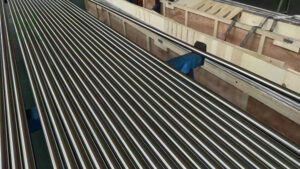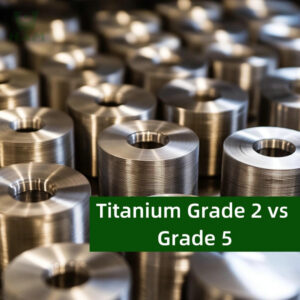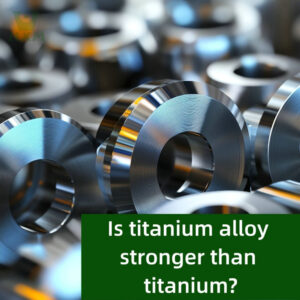
When it comes to high-performance materials, Inconel and Titanium are among the most widely used in industries such as aerospace, chemical processing, and medical manufacturing. Both materials are known for their strength, corrosion resistance, and ability to withstand extreme conditions. However, their unique properties make them suitable for very different applications.
In this article, we’ll explore the properties, types, mechanical characteristics, and applications of both Inconel and Titanium, along with a detailed comparison to help you make an informed decision for your specific needs.
What is Inconel?-Inconel vs Titanium
Inconel is a family of nickel-based superalloys known for its exceptional strength, corrosion resistance, and thermal stability in extreme environments. These properties make it ideal for use in industries such as aerospace, chemical processing, and energy production.

Inconel 601 UNS N06601 has excellent oxidation resistance at high temperatures, very good resistance to carbonization, can be very good oxidation resistance sulfur-containing atmosphere, at room temperature and high temperatures have very good mechanical properties very good resistance to stress corrosion cracking properties due to the control of the carbon content and grain size.
Inconel 601 has a high creep fracture strength, so in the field of 500 ℃ above the recommended use of Inconel 601.

Inconel 625(UNS N06625) is a corrosion and oxidation resistant nickel alloy used for its high strength and excellent resistance to water corrosion. Its excellent strength and toughness is due to the addition of niobium, which along with molybdenum hardens the matrix of the alloy.
Alloy 625 has excellent fatigue strength and stress corrosion cracking resistance to chloride ions. This nickel alloy has excellent weldability and is often used to weld AL-6XN. This alloy is resistant to a variety of severely corrosive environments and is particularly resistant to pitting and crevice corrosion.
Inconel Composition Table
| Grade | Nickel (%) | Chromium (%) | Iron (%) | Molybdenum (%) | Cobalt (%) | Other Elements |
|---|---|---|---|---|---|---|
| Inconel 600 | 72 | 14-17 | 6-10 | – | – | Carbon, Manganese, Silicon |
| Inconel 601 | 58-63 | 21-25 | Balance | – | – | Aluminum (1.0-1.7%), Silicon |
| Inconel 625 | 58 | 20-23 | 5 | 8-10 | 1.0 max | Niobium (3.15-4.15%), Carbon |
| Inconel 718 | 50-55 | 17-21 | Balance | 2.8-3.3 | – | Niobium (4.75-5.5%), Titanium (0.65-1.15%), Aluminum |
| Inconel 690 | 58-63 | 27-31 | 7-11 | – | – | Carbon, Silicon, Iron |
| Inconel 713 | 72 | 12.4-16 | Balance | – | 0.6-1.2 | Zirconium (0.05-0.15%), Titanium, Aluminum |
| Inconel 725 | 55-59 | 19-22.5 | Balance | 7-9 | – | Niobium (2.75-4%), Titanium |
| Inconel X-750 | 70 | 14-17 | Balance | – | – | Titanium (2.25-2.75%), Aluminum, Cobalt |
Key Features of Inconel
- High-Temperature Strength: Inconel retains its strength even at temperatures exceeding 700°C.
- Corrosion Resistance: Exceptional resistance to oxidation, acids, and high-temperature environments.
- Versatility: Available in various grades like Inconel 625 and 718 for specific applications.
Inconel Types
- Inconel 625: Known for its excellent corrosion resistance and weldability, often used in marine and chemical environments.
- Inconel 718: Offers high tensile strength and creep resistance, making it ideal for jet engine components and gas turbines.
Applications of Inconel
- Aerospace: Jet engines, turbine blades, exhaust ducts.
- Chemical Processing: Reactors, heat exchangers, and piping systems.
- Energy Sector: Nuclear reactors and power generation systems.
What is Titanium?-Inconel vs Titanium
Titanium is a lightweight, corrosion-resistant metal widely used in applications requiring high strength-to-weight ratios. It is especially valued for its biocompatibility, making it a preferred material in the medical field.
Titanium Composition Table
| Grade | Titanium (%) | Aluminum (%) | Vanadium (%) | Iron (%) | Oxygen (%) | Other Elements |
|---|---|---|---|---|---|---|
| Titanium Grade 1 | 99.5 | – | – | 0.2 max | 0.18 max | Hydrogen (0.015%), Nitrogen |
| Titanium Grade 2 | 99.2 | – | – | 0.3 max | 0.25 max | Hydrogen (0.015%), Nitrogen |
| Titanium Grade 3 | 99.0 | – | – | 0.3 max | 0.35 max | Hydrogen (0.015%), Nitrogen |
| Titanium Grade 4 | 99.0 | – | – | 0.5 max | 0.40 max | Hydrogen (0.015%), Nitrogen |
| Titanium Grade 5 (Ti-6Al-4V) | 90 | 6 | 4 | 0.25 max | 0.2 max | Hydrogen (0.015%), Nitrogen |
| Titanium Grade 7 | 99.2 | – | – | 0.3 max | 0.25 max | Palladium (0.12-0.25%) |
| Titanium Grade 9 (Ti-3Al-2.5V) | 92 | 3 | 2.5 | 0.25 max | 0.15 max | Hydrogen (0.015%), Nitrogen |
| Titanium Grade 11 | 99.5 | – | – | 0.2 max | 0.18 max | Palladium (0.12-0.25%) |
| Titanium Grade 12 | 99.2 | – | – | 0.3 max | 0.25 max | Molybdenum (0.2-0.4%), Nickel (0.6-0.9%) |
| Titanium Grade 23 (Ti-6Al-4V ELI) | 90 | 6 | 4 | 0.08 max | 0.13 max | Hydrogen (0.0125%), Nitrogen |
Key Features of Titanium
- Lightweight: Titanium’s density is only 4.5 g/cm³, nearly half that of Inconel.
- Corrosion Resistance: Excellent resistance to seawater and chemical environments.
- High Biocompatibility: Non-toxic and suitable for medical implants.
Titanium Types
- Grade 2 (Commercially Pure): Ideal for chemical processing and marine applications due to its excellent corrosion resistance.
- Grade 5 (Ti-6Al-4V): Known as the “workhorse alloy,” combining high strength and lightweight properties for aerospace and medical uses.
Applications of Titanium
- Aerospace: Aircraft components, landing gear, and fasteners.
- Medical: Implants, prosthetics, and surgical tools.
- Marine: Heat exchangers, seawater piping, and desalination systems.
What is the Difference Between Inconel and Titanium?-Inconel vs Titanium
Key Comparison Table
| Property | Inconel | Titanium |
|---|---|---|
| Density | 8.44 g/cm³ (heavier) | 4.5 g/cm³ (lighter) |
| Corrosion Resistance | Exceptional in oxidizing environments | Excellent in marine and chemical environments |
| Strength | Retains strength at high temperatures | High strength-to-weight ratio |
| Melting Point | ~1350°C | ~1668°C |
| Cost | Higher | Relatively lower |
In Aerospace:
- Inconel is better for turbine blades and engine components due to its ability to handle extreme heat.
- Titanium is preferred for airframe structures and parts where weight reduction is critical.
In Chemical Processing:
- Inconel withstands high-temperature acids and alkalis.
- Titanium is better for handling seawater and mildly acidic solutions.
Why Choose Huaxiao Alloy?
At Huaxiao Alloy, we specialize in providing premium-quality Inconel and Titanium products for diverse industrial applications. Our expertise and dedication to customer satisfaction make us a trusted partner in the materials supply industry.
Our Strengths
Comprehensive Product Range:
- Inconel Products: Tubes, bolts, plates, and custom components.
- Titanium Products: Bars, sheets, pipes, and precision parts.
Quality Assurance:
- All products meet international standards, ensuring reliability and durability.
Tailored Solutions:
- Customizable grades and dimensions to meet specific project needs.
Global Supply Chain:
- Efficient logistics to deliver products worldwide with minimal lead time.
Expert Support:
- Our experienced team provides technical advice and application-specific recommendations.
Conclusion
Inconel and Titanium are both exceptional materials tailored for specialized applications. Whether you need Inconel for high-temperature environments or Titanium for lightweight and corrosion-resistant solutions, making the right choice depends on your specific requirements.
Contact Huaxiao Alloy today to find the perfect material solution for your project. Let us provide you with the highest-quality alloys at competitive prices!

Inconel 601 UNS N06601 has excellent oxidation resistance at high temperatures, very good resistance to carbonization, can be very good oxidation resistance sulfur-containing atmosphere, at room temperature and high temperatures have very good mechanical properties very good resistance to stress corrosion cracking properties due to the control of the carbon content and grain size.
Inconel 601 has a high creep fracture strength, so in the field of 500 ℃ above the recommended use of Inconel 601.

Inconel 625(UNS N06625) is a corrosion and oxidation resistant nickel alloy used for its high strength and excellent resistance to water corrosion. Its excellent strength and toughness is due to the addition of niobium, which along with molybdenum hardens the matrix of the alloy.
Alloy 625 has excellent fatigue strength and stress corrosion cracking resistance to chloride ions. This nickel alloy has excellent weldability and is often used to weld AL-6XN. This alloy is resistant to a variety of severely corrosive environments and is particularly resistant to pitting and crevice corrosion.
- Inconel is ideal for suppressors exposed to extreme heat from rapid fire due to its thermal stability.
- Titanium suppressors are lighter, making them suitable for weight-sensitive applications.
- Aluminum: ~2.7 g/cm³ (lighter but weaker).
- Titanium: ~4.5 g/cm³ (heavier but significantly stronger).
Hastelloy excels in highly acidic environments, while Inconel performs better in high-temperature, oxidizing conditions.
At Huaxiao Alloy, we specialize in providing high-quality Inconel and Titanium materials for a wide range of applications.
Our Advantages
- Extensive Product Range: Inconel tubes, bolts, and sheets; Titanium bars, pipes, and plates.
- Custom Solutions: Tailored grades and dimensions to meet your needs.
- Global Supply Chain: Reliable delivery worldwide.
- Competitive Pricing: Best value for high-performance alloys.
Contact us today to find the perfect solution for your project!
| Property | Hastelloy C2000 | Hastelloy C276 |
|---|---|---|
| Chemical Additions | Contains copper for sulfuric acid resistance. | Contains tungsten for improved overall corrosion resistance. |
| Corrosion Resistance | Better in sulfuric acid and mixed acid conditions. | Better in reducing environments and against chlorides. |
| Applications | Used in chemical processing involving mixed acids. | Preferred in marine, pollution control, and general chemical industries. |
Key Difference: C2000 is optimized for sulfuric acid environments, while C276 excels in broader corrosive conditions.
Exceptional Corrosion Resistance:
- Handles both oxidizing and reducing environments.
- Resistant to chloride pitting, crevice corrosion, and stress corrosion cracking.
High Thermal Stability:
- Performs well in high-temperature environments.
Versatility:
- Suitable for chemical processing, marine, and pollution control applications.
Ease of Fabrication:
- Weldable and does not require post-weld heat treatment.
Durability:
- Long service life, reducing maintenance and replacement costs.
| Feature | Hastelloy C22 | Hastelloy C276 |
|---|---|---|
| Corrosion Resistance | Better in oxidizing environments. | Better in reducing conditions and against chlorides. |
| Weldability | Excellent. | Excellent. |
| Applications | Chemical processing and environmental equipment. | Broadly used in marine and chemical industries. |
Conclusion: Choose C22 for oxidizing environments and C276 for reducing and mixed conditions.
The ASTM standards for Hastelloy C276 include:
- ASTM B575: Specification for plate, sheet, and strip.
- ASTM B619: Specification for welded pipe.
- ASTM B622: Specification for seamless pipe and tube.
- ASTM B626: Specification for welded tube.
These standards define the alloy’s chemical composition, mechanical properties, and manufacturing tolerances.
Inconel vs Titanium
Call Us Now!!!










